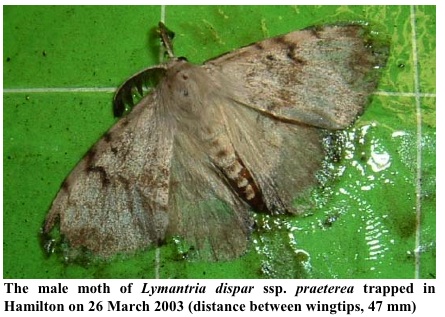PESTS AND DISEASES OF FORESTRY IN NEW ZEALAND
Asian gypsy moth in Hamilton
Scion is the leading provider of forest-related knowledge in New Zealand
Formerly known as the Forest Research Institute, Scion has been a leader in research relating to forest health for over 50 years. The Rotorua-based Crown Research Institute continues to provide science that will protect all forests from damage caused by insect pests, pathogens and weeds. The information presented below arises from these research activities.
From Forest Health News 128, April 2003.
The last decade has seen the sporadic detection of viable eggs and larvae of Asian Gypsy moth (Lymantria dispar) during routine inspections of imported items of cargo (FHNews 82:1). However, as far as is known this insect has never penetrated beyond the biosecurity barrier protecting New Zealand from exotic pests and diseases. Nevertheless, because of the potential for considerable economic loss should the moth ever become established, a national early-warning gypsy moth trapping programme was put in place in 1993 by the then Ministry of Forestry around all major ports and selected inland high risk sites. The programme is now maintained by MAF, who coordinate the inspection of over 1000 traps at least once every 10 days from November to April. The traps are baited with a sex pheromone to attract any male moths that develop from earlier stages should these escape border interception.
 Nothing significant was found during the first ten years of the programme, until last month when a curious single male moth was trapped in Hamilton. When Forest Research entomologists received this specimen they recognized it as a species of Lymantria and forwarded it to Dr Robert Hoare, Landcare Research, who identified it as Lymantria dispar subspecies praeterea . This subspecies occurs naturally in Siberia and Japan, and preliminary DNA work by Dr Karen Armstrong
Nothing significant was found during the first ten years of the programme, until last month when a curious single male moth was trapped in Hamilton. When Forest Research entomologists received this specimen they recognized it as a species of Lymantria and forwarded it to Dr Robert Hoare, Landcare Research, who identified it as Lymantria dispar subspecies praeterea . This subspecies occurs naturally in Siberia and Japan, and preliminary DNA work by Dr Karen Armstrong
(Lincoln University) indicates that the specimen is likely to have come from Iwate Prefecture in Japan. The males of L. dispar ssp. praeterea are lighter in colour than typical gypsymoths (see Figure).
Within days of the discovery, additional traps were deployed in a series of concentric bands extending out from the site where the moth was found, using recommendations contained in a contingency plan formulated in 1996. There are now
16 traps/km2 present within a 2km radius of the detection site, 8 traps/km2 within a 2-4 km radius, and 2 traps/km2 within a 4-7 km radius. In addition to this a further 75 traps have been placed alongside main routes in and out of Hamilton extending out to a 30 km radius. So far none of these traps has yielded any further moths. Intensive ground searching in the area where the moth was trapped failed to find any evidence of other life stages of the insect. Host trees and high-risk sites were targeted during this survey out to a radius of 1.5 km.
What was the source of the specimen, and why was only one moth trapped? Possible scenarios include:
- A larva pupated on a vehicle or container in Japan, which was then shipped to Hamilton; the moth emerged and was caught in the trap. Timing makes this scenario unlikely. In the northern hemisphere we would not expect gypsy moth pupae until about June.
- One or more egg masses were transported from Japan to Hamilton and at least some eggs hatched but most of the larvae perished. The moth trapped was the only one, or one of very few, that survived.
- There is a population of Asian gypsy moths elsewhere in New Zealand that we are not aware of; a pupa from this population was transported on a vehicle to Hamilton where the moth emerged and was trapped.
It is hoped that the last of these possibilities is not the correct one. We will be watching further developments closely.
Among the more than 5000 web sites reporting on Asian gypsy moth the following are helpful:
- http://www.exoticforestpests.org/english/Detail.CFM?tblEntry--PestID=11
- http://www.agf.gov.bc.ca/cropprot/gypsymoth.htm
- http://www.fs.fed.us/ne/morgantown/4557/gmoth/
For a concise summary, see also the Forest Research website:
http://www.forestresearch.co.nz/.
(John Bain, Forest Research, Mark Ross, MAF)
This information is intended for general interest only. It is not intended to be a substitute for specific specialist advice on any matter and should not be relied on for that purpose. Scion will not be liable for any direct, indirect, incidental, special, consequential or exemplary damages, loss of profits, or any other intangible losses that result from using the information provided on this site.
(Scion is the trading name of the New Zealand Forest Research Institute Limited.)



